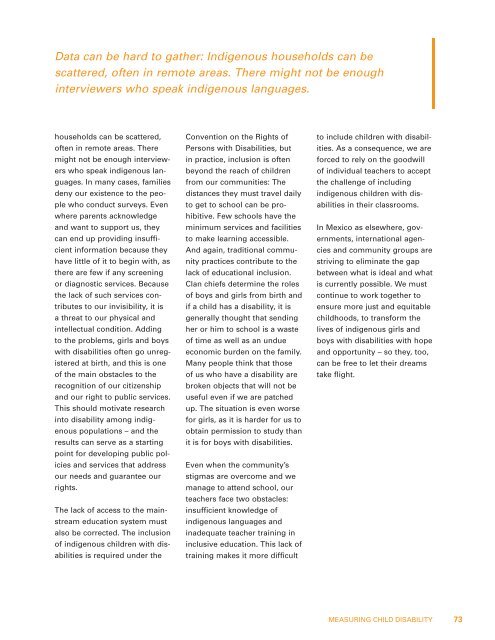State of the World's Children 2013 - Unicef
State of the World's Children 2013 - Unicef
State of the World's Children 2013 - Unicef
Create successful ePaper yourself
Turn your PDF publications into a flip-book with our unique Google optimized e-Paper software.
Data can be hard to ga<strong>the</strong>r: Indigenous households can be<br />
scattered, <strong>of</strong>ten in remote areas. There might not be enough<br />
interviewers who speak indigenous languages.<br />
households can be scattered,<br />
<strong>of</strong>ten in remote areas. There<br />
might not be enough interviewers<br />
who speak indigenous languages.<br />
In many cases, families<br />
deny our existence to <strong>the</strong> people<br />
who conduct surveys. Even<br />
where parents acknowledge<br />
and want to support us, <strong>the</strong>y<br />
can end up providing insufficient<br />
information because <strong>the</strong>y<br />
have little <strong>of</strong> it to begin with, as<br />
<strong>the</strong>re are few if any screening<br />
or diagnostic services. Because<br />
<strong>the</strong> lack <strong>of</strong> such services contributes<br />
to our invisibility, it is<br />
a threat to our physical and<br />
intellectual condition. Adding<br />
to <strong>the</strong> problems, girls and boys<br />
with disabilities <strong>of</strong>ten go unregistered<br />
at birth, and this is one<br />
<strong>of</strong> <strong>the</strong> main obstacles to <strong>the</strong><br />
recognition <strong>of</strong> our citizenship<br />
and our right to public services.<br />
This should motivate research<br />
into disability among indigenous<br />
populations – and <strong>the</strong><br />
results can serve as a starting<br />
point for developing public policies<br />
and services that address<br />
our needs and guarantee our<br />
rights.<br />
The lack <strong>of</strong> access to <strong>the</strong> mainstream<br />
education system must<br />
also be corrected. The inclusion<br />
<strong>of</strong> indigenous children with disabilities<br />
is required under <strong>the</strong><br />
Convention on <strong>the</strong> Rights <strong>of</strong><br />
Persons with Disabilities, but<br />
in practice, inclusion is <strong>of</strong>ten<br />
beyond <strong>the</strong> reach <strong>of</strong> children<br />
from our communities: The<br />
distances <strong>the</strong>y must travel daily<br />
to get to school can be prohibitive.<br />
Few schools have <strong>the</strong><br />
minimum services and facilities<br />
to make learning accessible.<br />
And again, traditional community<br />
practices contribute to <strong>the</strong><br />
lack <strong>of</strong> educational inclusion.<br />
Clan chiefs determine <strong>the</strong> roles<br />
<strong>of</strong> boys and girls from birth and<br />
if a child has a disability, it is<br />
generally thought that sending<br />
her or him to school is a waste<br />
<strong>of</strong> time as well as an undue<br />
economic burden on <strong>the</strong> family.<br />
Many people think that those<br />
<strong>of</strong> us who have a disability are<br />
broken objects that will not be<br />
useful even if we are patched<br />
up. The situation is even worse<br />
for girls, as it is harder for us to<br />
obtain permission to study than<br />
it is for boys with disabilities.<br />
Even when <strong>the</strong> community’s<br />
stigmas are overcome and we<br />
manage to attend school, our<br />
teachers face two obstacles:<br />
insufficient knowledge <strong>of</strong><br />
indigenous languages and<br />
inadequate teacher training in<br />
inclusive education. This lack <strong>of</strong><br />
training makes it more difficult<br />
to include children with disabilities.<br />
As a consequence, we are<br />
forced to rely on <strong>the</strong> goodwill<br />
<strong>of</strong> individual teachers to accept<br />
<strong>the</strong> challenge <strong>of</strong> including<br />
indigenous children with disabilities<br />
in <strong>the</strong>ir classrooms.<br />
In Mexico as elsewhere, governments,<br />
international agencies<br />
and community groups are<br />
striving to eliminate <strong>the</strong> gap<br />
between what is ideal and what<br />
is currently possible. We must<br />
continue to work toge<strong>the</strong>r to<br />
ensure more just and equitable<br />
childhoods, to transform <strong>the</strong><br />
lives <strong>of</strong> indigenous girls and<br />
boys with disabilities with hope<br />
and opportunity – so <strong>the</strong>y, too,<br />
can be free to let <strong>the</strong>ir dreams<br />
take flight.<br />
MEASURING CHILD DISABILITY<br />
73

















